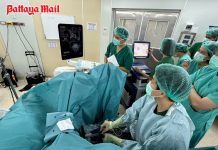One of the diagnostic tests that can be done to see if your coronary arteries are in good health is known as the 64 Slice CT. I was reminded of this the other day when a friend presented at the hospital with a request for this procedure to be done.
This test is for Coronary Heart Disease which refers to the gradual build up of ‘plaque’ (and it is not the dental kind) in the inside of the coronary arteries, the arteries that ‘feed’ the heart muscle.
What is often not realized is that the heart muscle does not get its oxygenation from the blood inside its chambers, but through separate arteries that run around the heart and supply the heart muscle directly. These are called the Coronary arteries. If the inside diameter of the coronary arteries is reduced by 50 percent, it means that the oxygen required cannot be supplied in enough quantities to keep the heart muscle alive when it is called to perform extra work, such as running to (or out of the way of) a baht bus, for example. Constriction greater than 50 percent means that the heart muscle ‘starves’ of oxygen even more quickly.
We know these days that the ‘plaque’ build-up is made of cholesterol and calcium, and that the likelihood of deposits depends on many factors, including diabetes, high blood pressure, high cholesterol levels, stress and cigarette smoking. This is why we advocate regular testing for those physical factors, and strongly advise you to give up smoking! We actually do want you to live a little longer, with a good quality of life.
To diagnose coronary artery disease, we will evaluate a patient’s risk factors and perform some tests and then divide the patients suspected to be at risk into the two groups; high and low risk. After that, there are two main diagnostic procedures that will usually be performed, conventional coronary angiography or the 64-Slice CT.
Conventional Coronary AngioGraphy (CAG because we medico’s love acronyms, as you know), is probably the ‘gold standard’ to accurately assess the coronary arteries, and gives an immediate clinical evaluation of known or suspected coronary artery disease. At this time, if blockages are found, the patients are already prepped and balloon and stent can be inserted. An immediate treatment which gets the patient quickly out of danger in the short term.
However, whilst it may be the gold standard, it is also expensive (like gold) and time consuming, as it requires a stay in hospital of four to six hours. Being a direct intervention, with cardiac catheters, there can also be a risk of hemorrhage, though this is not usually the case. But it can happen. There is always a degree of risk with all invasive procedures.
The alternative is the 64-Slice-CT, which is not an invasive procedure. This is a variation of CT scanning, with the original known as 16-slice CT. This was fine for assessing organs which did not move, but was not as accurate in demonstrating coronary artery problems, because the heart is moving and beating inside the chest (unless, of course, if you have died already). However today, with the advent of the most advanced form of this imaging, the multi-slice detectors and high powered computer programs called the 64-Slice CT we can efficiently get information on the coronary arteries in as few beats as possible, in around 4 seconds. And this comes with 90 percent accuracy.
The 64-Slice CT has many advantages. First off, nobody is actually slicing you open to insert cardiac catheters into your arteries. The 64 ‘virtual’ slices are done of your cardiac image and the coronary arteries by the computer program, not physically. Each slice is 0.625 mm, so will be able to pinpoint calcium deposits. It is a quick and painless procedure. You do not have to wait around in hospital afterwards, other than perhaps wait for the radiologist’s report. A boon for the busy businessman (the group most at risk). And finally, it is much cheaper than having a coronary angiogram.
So, how did my friend’s 64-Slice CT turn out? A 90 percent blockage of one coronary artery, so now to CAG for balloon and stent.




